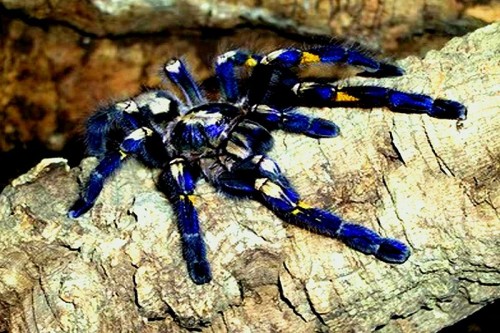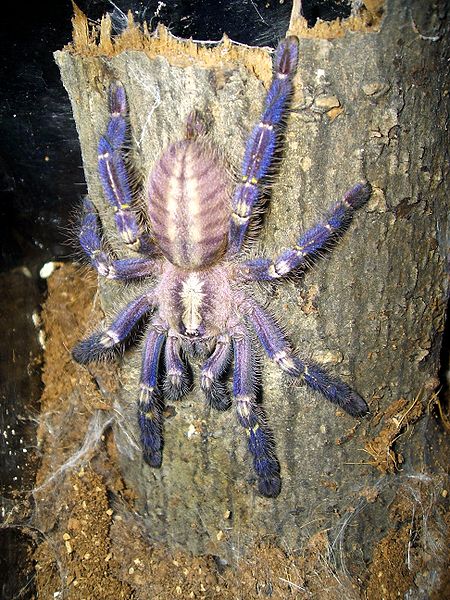Who am I?
My name is Gooty Tarantula.

What are some of the other names given to me?
I am also called,
1. Gooty sapphire ornamental tree spider,
2. Gooty sapphire,
3. Parachute peacock spider
4. Metallic tarantula
5. Peacock tarantula
6. Salepurgu
…phew!
Scientists call me –
Poecilotheria metallica
What is a tarantula?
A very large spider with long hairy legs. They kill their prey using venomous fangs.
Why is the name peacock or sapphire prefixed to my name?
Because, I am a metallic blue coloured spider, quite attractive like the peacock or the blue sapphire.
Why then the name Gooty tarantula?
I was first discovered in the town of Gooty in Andhra Pradesh and that too in a railway timber yard. So people started calling me the Gooty tarantula. But here is the secret – I never really lived there! Many experts are sure that I actually came to Gooty along with the timber and my real home is the Eastern Ghats where I live now, a 100 km away from Gooty. Talk about first impressions!
Where do I live?
In deciduous forests of Andhra Pradesh in India. Nowhere else in the world. In fact, my home range is less than a 100 sq. kms in a reserve forest between Nandyal and Giddalur. I love living inside tree holes creating my tunnel webs inside.
What do I eat?
Tasty flies, moths, fruit flies, mantis etc. Any insect that flies around me; I seize it in flight, paralyze it and gobble up.
Where am I placed in the IUCN Red List of Threatened Species?
They say I am Critically Endangered and face an extremely high risk of extinction.
Why am I so rare and threatened?
The forest I like to live in is getting smaller each day because of growing need for timber. People are also clearing the forests for building homes, converting to croplands etc.
Some people also hunt for me to sell as exotic pets. It is thought that few tarantula lovers in the US are ready to pay as much as $500 to buy me as a pet. Sadly, if only the same money could be spared to save my forest home, I could easily live longer and never be extinct.
Why do I hate humans?
I don’t. I just do not like showing myself to them because most of them are not nice to me. I am so rarely seen that even scientists who spent years looking for me have not been able to spot me in spite of my beautiful metallic blue colour.
I was first discovered in 1899 in the railway timber yard of Gooty, then was seen in 2001 and was again discovered 113 years later recently at Seshachalam Biosphere reserve spread across Chittoor and Kadapa districts of Andhra Pradesh.
Do I still exist or am I already extinct?
It is difficult to guess although I was seen as recently as in 2013. If my forests, and trees with nice, comfortable holes are preserved, surely I’ll be seen again. And you might not even have to wait a 100 years for it!
More Related Stories,
Critically Endangered Spider seen after 113 Years
57 Animal Species Critically Endangered in India
Research Centre to Study Spiders
Image via Wikimedia commons










I have one of these little beauties in captivity. Beautiful creatures and so fascinating. It’s a shame they are so so rare in the wild. Nice little piece on them though 🙂
That’s interesting Lucy. In the wild, their habitat is in danger, which is making them a very rare species. You have a very precious spider as a pet..:) the rarest of its kind.
You should save the forest for the spider and put monitors in the reserved area for reaching
Good Afternoon,
I see a lot of P.metallicas being bred in captivity in the United States. Is there any effort being made by tarantula hobbyists to help this cause? There’s no shortage of P.metallica slings in the hobby. I see hobbyists breeding them all the time.
If the tarantulas could be guaranteed a sanctuary in their native habitat, I’m sure hobbyists would be willing to breed to reintroduce the species, myself included. If this is something I’d like to pursue, where would you suggest starting?
Hi Natalie, That is a very nice thought and certainly a good idea to work on. However, currently I do not have any knowledge if something like this is being planned.We would love to get in touch with experts who would want to collaborate in such an experiment for the conservation of the spiders and breeding them in their native habitat.